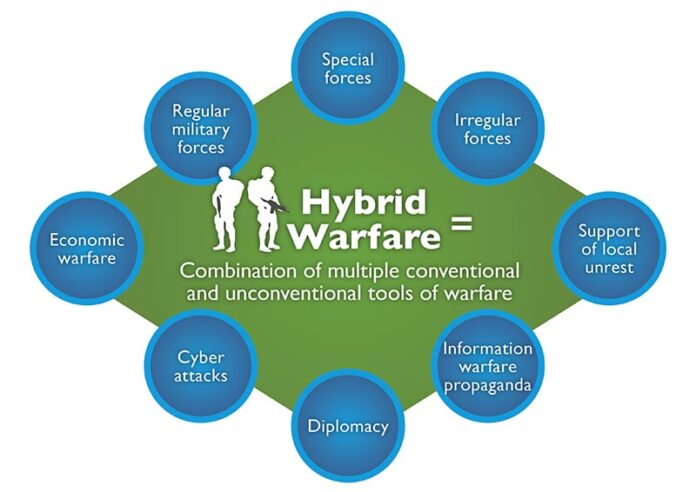“Every age has its own kind of war, its own limiting conditions, and its own peculiar preconceptions.”—Carl von Clausewitz
Amid the very global battle, all countries are straining their every sinew to overcome their adversaries politically, economically, in general, regionally, in particular. Every country seems to be hellbent on standing out prominently across the globe.
To achieve these goals, many countries, historically, had employed overt tactics for knocking their regional rivals down peg in order to have their edge over them. But the age of overtly exerting influence, invading through regular military tactics, has gone. The present-day global war is quite unique in nature which includes military strategy that blends conventional warfare, so-called ‘irregular warfare’ and cyber-attacks with other influencing methods, such as fake news, diplomacy and foreign political intervention, and is currently known as “hybrid warfare”.
“Hybrid Warfare”, nicknamed as “grey zone warfare”, is the latest modus operandi in fighting that seems dead common but leaves very deadly effects. Before moving on and discussing the lethality and consequences of this warfare, it is essential to learn a more comprehensive definition.
The 2015 edition of Military Balance provides a very comprehensive definition of the latest manifestation of hybrid warfare, highlighting the methods employed, namely “the use of military and non-military tools in an integrated campaign, designed to achieve surprise, seize the initiative and gain psychological as well as physical advantages utilizing diplomatic means; sophisticated and rapid information, electronic and cyber operations; covert and occasionally overt military and intelligence action; and economic pressure.” Additionally, NATO defined it as: “hybrid threats combine military and non-military as well as covert and overt means, including disinformation, cyberattacks, economic pressure, deployment of irregular armed groups, and use of regular forces. Hybrid methods are used to blur the lines between war and peace, and attempt to sow doubt in the minds of target populations.”
after learning the definition, now, we will now have a glimpse at the chronological perspective in order to see the practical manifestation of also called non-linear war.
During the 2000s, the use of the term “hybrid” became a common way to describe contemporary warfare, particularly because of the increasing sophistication and lethality of violent non-state actors and the growing potential of cyber warfare.
Further, in 2006, during the conflict between Israel and Hezbollah, this term was frequently used.That was an example of a war that fitted contemporary definitions of hybrid warfare. Hezbollah, which had been trained and equipped by Iran, surprised Israel with its sophisticated combination of guerrilla and conventional military tactics and employed weaponry and communication systems normally associated with the armed forces of developed states. At the strategic level, Hezbollah made effective use of the Internet and other media for information and propaganda. Its information management proved much more successful than Israel’s in influencing global opinion from the start of the conflict.
More importantly, while discussing the very hybridity of warfare, when this term went on peak, it was tried out elsewhere, as by Russia against Ukraine. Russia can, at no level, be condoned for practicing this lethal mode of fighting in occupying parts of Ukraine and the whole of Crimea. In 2014, Russia, while using asymmetric tactics of war began to spread disinformation, and made intense use of cyber-attacks. To annex Crimea, the Russian Federation supported separatist groups in eastern Ukraine. Russian techniques included the traditional combination of conventional and irregular combat operations, but also the support and sponsorship of political protests, economic coercion and other such tactics.
Keeping in view the lethality of this latest phenomenon, Pakistan must learn a lesson and devise a strategy by using all required paraphernalia in every arena to counter India and strengthen its cyber-security.
The Russian approach to hybrid warfare does not exclude the direct use of military force when necessary. In summer 2014, when Russia had exhausted its use of non-military hybrid methods, military operations in Ukraine took on the character of limited conventional war. Russian battalion tactical groups (BTG) intervened directly in combat against the Ukrainian army.
China’s People’s Liberation Army is also a potential adversary in hybrid warfare. Members of the PLA were recently indicted by the USA for hacking Equifax’s computer systems. In that September 2017 attack, the personal information of 145.5 million Americans, 400,000 Britons and 19,000 Canadians was exposed, including credit records, addresses, and credit and debit card numbers.
In October 2019, hackers obtained personal identifiable information from three hospitals in southwestern Ontario: Listowel, Wingham and Michael Garron (formerly Toronto East Hospital). At Garron, the malware targeted computer systems that collected information, demanding a ransom to retrieve data that had been encrypted by the attack, and causing major disruptions for patients and staff, who had to resort to transcribing patient data by hand onto paper
The City of Woodstock fell victim to a cyber attack. It chose not to pay a ransom, but it spent $1.04 million on recovering and re-equipping its system.
On the other hand, the City of Stratford paid $75,000 worth of Bitcoin to obtain encryption keys to unlock its system information after a cyber attack.
Surprisingly, Pakistan’s old-cum-arch foe India has left no stone unturned in this respect to keep Pakistan unstable politically, economically, diplomatically, and especially endogenously, by multi-pronged tactical intrigues. Arguably, since the CPEC accord, it has been employing techniques of stirring up insurgency in Balochistan; people are divided linguistically and ethnically. They are pitched against their own security institutions and the sense of deprivation is created in them as well.
Let me borrow few lines from an article, published in a Pakistani newspaper, on 3 June 2018 to adduce my viewpoint, ‘a latest book Spy Chronicles, co-authored by Asad Durrani, Ex-ISI chief, and his Indian counterpart AS Dulat, Ex-head of RAW. While discussing the importance of Balochistan, Asad Durrani writes, “It is an important area for different purposes. Some are there to blow up the pipeline Iran and Pakistan want to build or to sabotage the economic corridor; others because they don’t want to miss out on what the first lot are planning. The place is crucial for the ‘New great game’.”’
That vividly depicts the techniques of hybrid warfare are used by India to destabilize Pakistan.
Moreover, NATO policy-makers stated that a new era of conflict has begun. To cope with these indigenous warfare attacks, NATO seems to devise a strategy and is making efforts to collect and evaluate information about hybrid attacks directed against its member states.
It is also developing rapid-reaction cyber-defence teams that can be sent at an ally’s request in a crisis. The cyber teams work on civil emergency planning, critical infrastructure protection, counterterrorism and energy protection.
NATO wants to prevent conflicts from escalating and seeks to develop counter-strategies that would improve intelligence sharing. Beyond NATO, more units are being dedicaated to deal with hybrid threats, such as the European Centre of Excellence established by Finland. But all this work requires the sharing of confidential information and classified documents, which means significant trust must be built.
Keeping in view the lethality of this latest phenomenon, Pakistan must learn a lesson and devise a strategy by using all required paraphernalia in every arena to counter India and strengthen its cyber-security. In addition, The RCMP urges not to pay any ransom to the hackers, it further stated that after payment there is no surety of the recovery of data but it may bolster to further their such nefarious techniques.























“Surprisingly, Pakistan’s old-cum-arch foe India has left no stone unturned in this respect to keep Pakistan unstable politically, economically, diplomatically, and especially endogenously …”
Not a surprise …… after dancing a lot about his perception about ‘hybrid warfare’ and blah blah, like most Pakistani writers, Sanwal Ali Rind also in his writeup came, after day long grazing below the Berry Tree i.e. INDIA, like a she-donkey. Please don’t blame India for your foolishness either in Baluchistan, Sindh, NWFP or in East Pakistan. 😆
As regards to Baluchistan I suggest him to read more about Pakistan’s illegally occupied suzerainties of Kalat, Lasbela, Kharan, Makran, Bolan, Bugti, Kohlu areas and killing of thousands of innocent Baloch in Pakistan’s full fledged wars against Bloch. The wars, First in 1948 led by Prince Abdul Karim Khan; Second in 1958 by Nawab Nowroz Khan; Third in 1963-69 by Sher Mohammad Bijarani Marri; Fourth in 1973-77 by Nawab Khair Baksh Marri and Fifth which is going on since 2004 to till date in which Nawab Akbar Khan Bugti gave his Shahadat. The Bloch are continuously crying for their freedom from Pak tyranny as Bengalese. The entire world is also aware about the facts of Turbat Killings and the uprising of Mir Suleiman Dawood? Today the situation is so grave that NO Pakistani from other areas can roam in Baluchistan without security. Are Indians stopping Chinkys or you from going in Baluchistan? 😆
True Bro, Pakistan has not learned a lesson from 1971 and repeating same mistakes blaming India. 🤔
Changez d’obsession et arrêter le paranoia . La vraie puissance et la puissance économique.
Vos concepts sont ceux de votre armée qui les utilise pour continuer à engloutir une grande partie de votre PIB au lieu de l’investir dans le développement et l’épanouissement de votre pauvre pays
Most momentous and Splendid write-up drafted by Sir Sanwal Ali Rind Sahab….. Hats off to you Dear Brother Sanwal Ali Rind Sahab ❤️❤️❤️❤️❤️❤️❤️❤️❤️❤️❤️❤️❤️❤️❤️❤️❤️❤️❤️❤️❤️❤️❤️❤️🌹🌹🌹🌹🌹🌹🌹🌹🌹🌹🌹🌹🌹🌹🌹🌹🌹🌹🌹🌹🌹🌹🌹🌹🌹🌹🌹🌹🌹🌹🌹🌹🌹🌹🌹🌹🌹✌️✌️✌️✌️✌️✌️✌️✌️✌️✌️✌️✌️✌️✌️✌️✌️✌️✌️✌️✌️✌️✌️✌️✌️✌️✌️✌️✌️✌️✌️✌️✌️✌️✌️✌️✌️